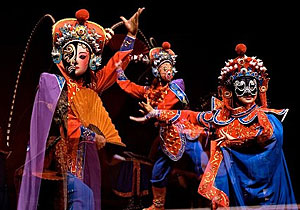Sichuan Opera and Face Changing

Sichuan opera is a type of the oldest Chinese opera most prevailing in southwest China. It is individualized by exclusive solos, elaborate acting, abundant percussion, and talented comedians as a whole. Today it has become a combination of five historic sonic styles – Gaoqiang, Kunqiang, Huqing voice, Tanxi, and Dengxi (Lantern Theater), which were emerged with local dialects, folk customs, ditties, etc. Among the five Gaoqiang is the main sing style which possesses the most local characteristics and the richest and most beautiful melodies.
The histories of different Sichuan opera styles vary greatly from each other, while its main form was originated around the 18th century. Since then, thousands of Sichuan opera plays came into being, which were flourishing in the splendid local culture as well as the Chinese opera. Some of the most famous traditional plays include "Five Gowns", "Five Pillars" and so on. "The Tale of the White Serpent – Jinshan Temple" as an excellent representative Sichuan opera play, is so well known not only in China but also abroad.
Sichuan opera displays many special techniques such as face-changing, spitting fire, and rolling light, while face-changing (Bian Lian) is the most wonderful and sophisticated technique which utilizes colorful lianpu (Chinese opera facial make-up or colored masks) to reflect the roles' changing emotions and moods so as to make the audience better understand the play plots. This form of art began 300 years ago and has undergone a series of developments in terms of the face changing methods and its materials.
There are three basic methods of face-changing: smearing, blowing, and pulling. With the method of smearing face, performers smear their faces with colored paste concealed in the palms of their hands. And by "blowing face", they change the colors of their face by blowing into a box of gold, silver or black powder. The powder would adhere to their oiled skin immediately. The most commonly used method today is "pulling face", which is, literally, that opera masters pull off layers of painted silk masks one after another in less than a fraction of a second that audience have no way to notice how it is done. Some famous Chinese opera master used to pull off as many as 24 faces.
Face-changing requires very skilled performers with relentless practice. It is an amazing art form in Sichuan opera which will probably dazzle your eyes.